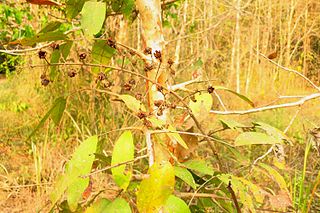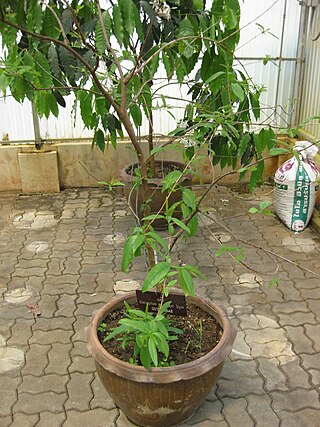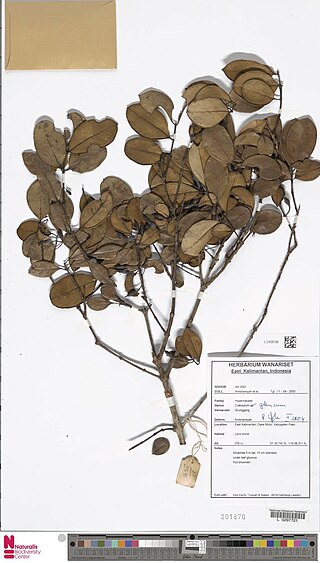
Cratoxylum arborescens is a plant in the family Hypericaceae. The specific epithet arborescens is from the Latin meaning "tree-like".

Cratoxylum cochinchinense is a plant now placed in the family Hypericaceae. The specific epithet cochinchinense is from the Latin meaning "of Cochinchina". In Vietnamese C. cochinchinense is usually called thành ngạch nam or lành ngạnh nam, other names include: hoàng ngưu mộc, hoàng ngưu trà and đỏ ngọn.

Cratoxylum maingayi is a plant in the family Hypericaceae. It is named for the botanist Alexander Carroll Maingay.
Brackenridgea palustris is a tree in the family Ochnaceae. The specific epithet palustris is from the Latin meaning "swampy", referring to the species' habitat.
Maranthes corymbosa is a tree in the family Chrysobalanaceae. The specific epithet corymbosa is from the Greek meaning "cluster", referring to the clustered inflorescences.
Mastixia glauca is a tree in the family Nyssaceae. The specific epithet glauca is from the Greek meaning "bluish-grey", referring to the colour of the leaf underside.
Mastixia macrocarpa is a tree in the family Nyssaceae. The specific epithet macrocarpa is from the Greek meaning "large fruit".
Diospyros andamanica is a tree in the family Ebenaceae. It grows up to 20 metres (70 ft) tall. Twigs are rusty brown or blackish. Inflorescences bear up to 30 or more flowers. The fruits are roundish to ellipsoid, up to 3 cm (1 in) in diameter. The tree is named after the Andaman Islands. Habitat is mixed dipterocarp forests from sea level to 700 metres (2,300 ft) altitude. D. andamanica is found in the Andaman Islands, Sumatra, Peninsular Malaysia and Borneo.
Diospyros parabuxifolia is a tree in the family Ebenaceae. It grows up to 15 metres (50 ft) tall. The fruits are ellipsoid, up to 2 cm (1 in) in diameter. The specific epithet parabuxifolia is from the Greek meaning "similar to D. buxifolia". Its habitat is lower montane forests from 1,000 metres (3,300 ft) to 1,500 metres (5,000 ft) altitude. D. parabuxifolia is endemic to Borneo and confined to Sarawak.
Dysoxylum oppositifolium is a tree in the family Meliaceae. The specific epithet oppositifolium is from the Latin meaning "opposite leaf", referring to the leaves being on opposite sides of the stem.
Alangium kurzii is a tree in the family Cornaceae. It is named for the German naturalist Wilhelm Sulpiz Kurz.
Alangium rotundifolium is a tree in the family Cornaceae. The specific epithet rotundifolium is from the Latin meaning "rounded leaves".

Canarium hirsutum is a tree in the family Burseraceae. The specific epithet hirsutum is from the Latin meaning "bristly", referring to the rough hairs of the fruit.
Canarium denticulatum is a tree in the family Burseraceae. The specific epithet denticulatum is from the Latin meaning "small teeth", referring to the leaf margin.
Kostermanthus heteropetalus is a tree in the family Chrysobalanaceae. The specific epithet heteropetalus is from the Greek meaning "uneven or unequal petals".

Cratoxylum glaucum is a plant in the family Hypericaceae. The specific epithet glaucum is from the Latin meaning "blue-green", referring to the colour of the leaf underside.
Engelhardia roxburghiana is a tree in the family Juglandaceae. It is named for the Scottish botanist William Roxburgh.

Strombosia is a plant genus of about 10 species in the family Olacaceae. It has also been classified in the family Strombosiaceae. The generic name is from the Greek strombos, meaning "pear-shaped", referring to the fruit.

Lithocarpus lucidus is a tree in the beech family Fagaceae. The specific epithet lucidus is from the Latin meaning "shining", referring to the acorn and leaf surface.

Strombosia pustulata is a species of tree in the family Olacaceae. It is native to the rainforests of tropical West and Central Africa. Common names for this tree include itako in Nigeria, afina in Ghana, poé in Abé spoken in Côte d'Ivoire and mba esogo in Equatorial Guinea.








